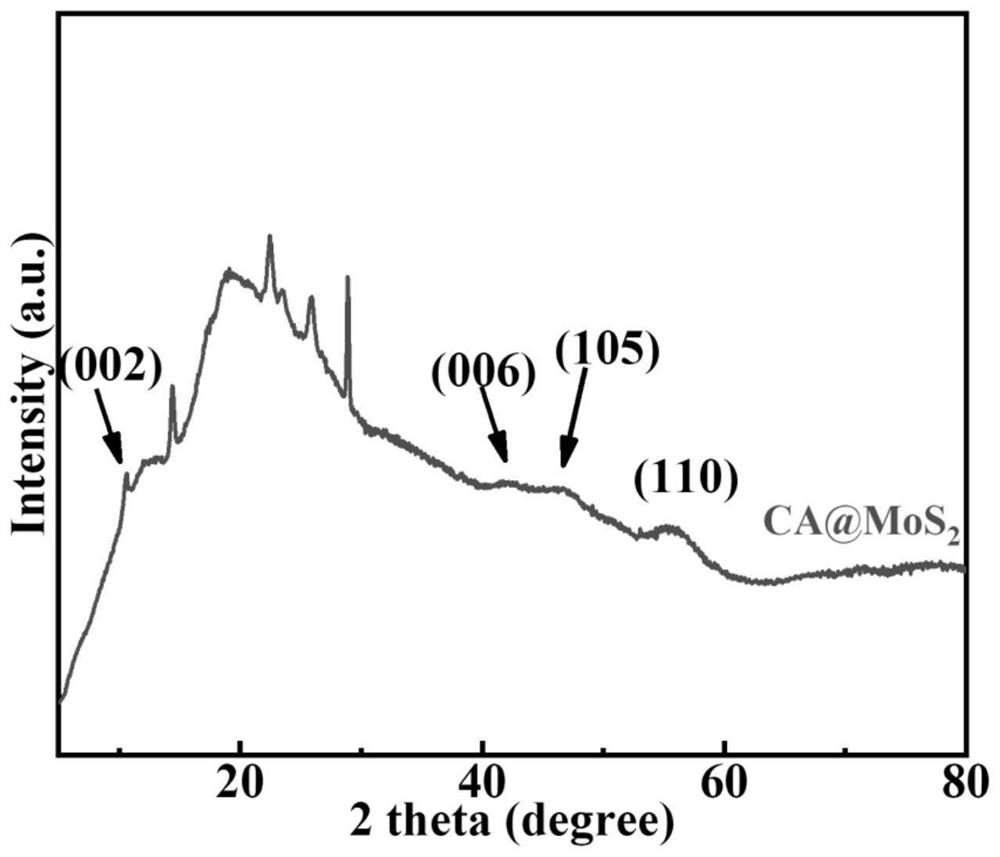Cross-linked cellulose@molybdenum disulfide aerogel composite adsorbent as well as preparation method and application thereof
A technology of cellulose airgel and molybdenum disulfide, applied in chemical instruments and methods, alkali metal compounds, adsorbed water/sewage treatment, etc., to achieve excellent adsorption capacity, excellent lead ion adsorption performance and adsorption selectivity, and solve the problem of water big damage effect
- Summary
- Abstract
- Description
- Claims
- Application Information
AI Technical Summary
Problems solved by technology
Method used
Image
Examples
preparation example Construction
[0032] A crosslinked cellulose @ disulfide molybdenum gel composite adsorbent is obtained by negative laminar molybdenum sulfide nanoparticles on the carrier; the carrier is a porous structure generated by cellulose crosslinked by epoxy chloropropane. The cellulose airgel, the inside of the carrier pore and the surface are uniformly distributed with a splitonal molybdenum nanoparticle; the innermost diameter of the carrier is 50-500 μm; the antlyptallidide nano particle size is 20-400 nm. The preparation method of the adsorbent includes the steps of:
[0033](1) The cellulose is added to a sodium hydroxide / urea mixture pre-cooled to -12 ° C, and the clear and transparent cellulose solution is obtained after high-speed stirring at 1000-2500 rpm; hydroxide in the sodium hydroxide / urea solution. The sodium mass fraction is 7-9 wt%, the urea mass fraction is 12-14 wt%; the ratio of the quality of the cellulose and the volume of sodium hydroxide / urea mixed solution is 30-50 μg / ...
Embodiment 1
[0037] Example 1: Crosslinked cellulose @ 二 二 molybdenum gel composite adsorbent
[0038] Step (1): Take 5 g of cellulose dissolved in 7 wt% / 9 wt% of 100 g of a 7 wt% / 9 wt% sodium hydroxide / urea mixed solution, stirring at high speed at 2000 rpm to give a clear and clear cellulose solution.
[0039] Step (2): Take 8G MOS 2 In the cellulose solution obtained from step (1), ultrasonic stirring was 30 min to obtain a uniformly dispersed diombite / cellulose suspension.
[0040] Step (3): Add 15 mL of epoxy chloropropane to step (2) to the mixing solution obtained using a peristaltic pump, followed by stirring at 300 rpm, and the resulting mixed solution is reacted at 60 ° C for 2 h.
[0041] Step (4): Use deionized water and anhydrous ethanol to remove the hydrogel obtained by step (3) to neutral, pre-freeze at -35 ° C for 12 h, then vacuum dried at -50 ° C to obtain a sulfide solution Floor cellulose airgel composite adsorbent.
[0042] like figure 1 As shown, the scanning ele...
Embodiment 2
[0043] Example 2: Crosslinked cellulose @ 二 钼 钼 复 吸 吸 吸 吸 应用 子 吸 附
[0044] 25mg Ca @ MOS 2 The composite adsorbents were added to 50 ml of different concentrations of lead ion solution, and the solution concentration ranged from 5 to 500 mg / g, and the temperature of 25 ° C and 45 ° C, pH were controlled at 4.5 ± 0.3. Elever 24 hours to ensure adsorption balance. Take the supernatant to measure the residual lead ion concentration of the solution, resulting in a balanced adsorption amount at different initial lead ion concentrations, and the maximum adsorption amount at 25 ° C is 160 mg / g, 45 ° C is sucking up to 180 mg / g.
PUM
| Property | Measurement | Unit |
|---|---|---|
| pore size | aaaaa | aaaaa |
| size | aaaaa | aaaaa |
| particle diameter | aaaaa | aaaaa |
Abstract
Description
Claims
Application Information
 Login to View More
Login to View More - R&D
- Intellectual Property
- Life Sciences
- Materials
- Tech Scout
- Unparalleled Data Quality
- Higher Quality Content
- 60% Fewer Hallucinations
Browse by: Latest US Patents, China's latest patents, Technical Efficacy Thesaurus, Application Domain, Technology Topic, Popular Technical Reports.
© 2025 PatSnap. All rights reserved.Legal|Privacy policy|Modern Slavery Act Transparency Statement|Sitemap|About US| Contact US: help@patsnap.com



